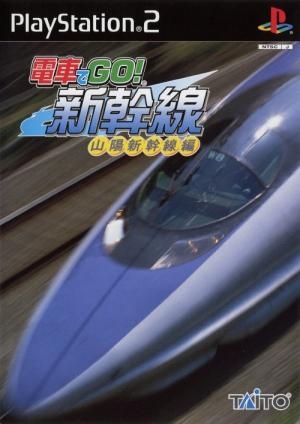
| Aka: | Densha de Go! Shinkansen - Sanyou Shinkansen-hen |
| Console: | Sony Playstation 2 |
| TV Standard: | Region Not Set |
| Developer(s): | Taito Corporation |
| Publisher(s): | Taito Corporation |
| Release Date: | 2001-11-20 |
| Players: | 1 |
| Co-op: | No |
| ESRB: | E - Everyone |
| Type: | Vehicle Simulation |
Densha de Go! is a Japanese train simulation game series originally produced by Taito and more recently by Square Enix (who purchased Taito) and Railfan Holdings Co., Ltd. The game originates from a 1996 arcade version. There are also PC versions released by the Japanese publisher Unbalance. All of the games in the series are available in Japanese only. The latest chapter in the series was released on June 15, 2011 for Apple iOS devices.
GAMEPLAY:
Each Densha de Go title contains actual train (or tram) routes based on real services in Japan. For the most part, the user's task is to drive the train and adhere to a very exacting timetable, including stopping at stations to within as little as 30 cm of a prescribed stopping point, ideally within half a second of the scheduled arrival time.
As a train conductor in a populous Japanese city, you are responsible for bringing a legion of salarymen, school tykes and kogals to and from their daily rounds. Pull into a station and watch the ridership step lively onto and off your train. Keep an eye on your schedule and hit the platforms just right for perfect scores and happy riders. Your train journeys take you from the morning to afternoon to night and weather conditions affect your ability to control your train. Rainy weather means the tracks will decrease braking efficiency and you'll have to adjust your speed and brakes accordingly. Players travel through Kyushu, Kanto and Kinki on the Kagoshima, Sasaguri and Sanyo main lines.
Three districts, six lines, and 16 different engines are available as you attempt to make it to the station on time through careful manipulation of the special DDG controller (now with separate whistle pedal peripheral).
The big technological advancement in DDG3, along with the expected graphical improvements that PS2 makes possible, is the addition of more realtime progression elements in the game. Day and night will pass realistically (you can start in the morning, afternoon, evening, and night), and the weather will change depending on the time of day, the season, and the region you're passing through. That will affect gameplay, since rain will make the track slippery and affect your acceleration and braking performance.
The Shinkansen Controller for the PS2 comes with a LED screen display of speed and controls and a foot pedal to blow the horn, whereas the Shinkansen Controller for the Wii lacked these features, replacing the LED screen with a representative sticker. The Wii version of this controller commands much higher prices than the PS2 version by virtue of relative rarity.
Densha de Go! Shinkansen Sanyou Shinkansen-hen, for PS2, PC, and Wii: Coverage included the Sanyo Shinkansen and Hakata Minami Line.
Known as bullet trains, the Shinkansen line began life in 1964 with the Tokaido express service. Even back in the day, the bullet trains hit a blistering 200km/h while modern models push the envelope further with speeds topping out at 300km/h. Renowned for their punctual and "on the dot" service commitments, the Shinkansen enjoy an excellent reputation among it's passengers.
As a newly appointed Shinkansen conductor, it's your job to maintain the level of pristine service that your riders have come to expect. Never fear if your train driving skills are a tad rusty, a training mode guides you through the rudimentary tasks and procedures to properly maneuver your train. The player may view the progress of the ride from a standard cockpit mode or from the vantage point of a camera which floats outside the train, just above the locomotive car.
Again, this version featured a significantly different basic graphics engine. Innovations included graphic interludes which showed routine passenger activities and the optional ability to see both the train from the outside and see a detailed, 3-dimensional cab view from the inside. Breaking the trend to this point, this title demanded more exacting driving by the user - often as little as half a second to correctly respond to speed limit change indications.
Despite the intrinsic appeal of being able to drive a train at over 300 km/h, this version suffers from somewhat repetitive gameplay, as the Sanyo shinkansen consists of a fairly monotonic series of tunnels and viaducts.
MANUFACTURER'S DESCRIPTION:
Popular train driving game series which recorded the Sanyo Shinkansen section. Can travel up and down the line of the first series. 0.100.300.500 system, the type that can be driving five models of Rail Star. Outer view of a third-person point of view and cockpit view can be selected. I have recorded many photos and model railroad to railroad photo other than "railway museum!"
FEATURES:
First person perspective.
3D graphics
Cartoon graphics
Trains theme.









